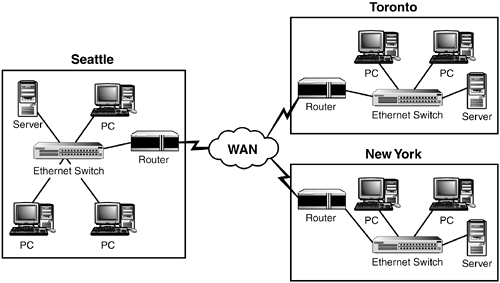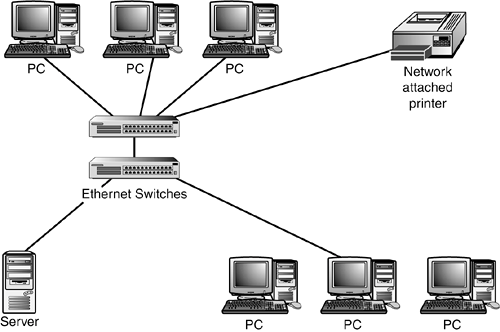LANs, WANs, and PANs
| Networks are classified according to their geographical coverage and size. The two most common network classifications are local area networks (LANs) and wide area networks (WANs). LANsA LAN is a data network that is restricted to a single geographical location and typically encompasses a relatively small area such as an office building or school. The function of the LAN is to interconnect workstation computers for the purposes of sharing files and resources. Because of its localized nature, the LAN is typically high speed and cheaper to set up than a WAN. Figure 1.1 shows an example of a LAN. Figure 1.1. Local area network.
WANsA WAN is a network that spans more than one geographical location often connecting separated LANs. WANs are slower than LANs and often require additional and costly hardware such as routers, dedicated leased lines, and complicated implementation procedures. Figure 1.2 shows an example of a WAN. Figure 1.2. Wide area network. PANsWireless technologies have introduced a new termWireless Personal Area Networks (WPAN). WPAN refers to the technologies involved in connecting devices in very close proximity to exchange data or resources. An example of this can be seen through connecting a laptop with a PDA to synchronize an address book. Because of their small size and the nature of the data exchange, WPAN devices lend themselves well to ad hoc networking. Ad hoc networks are those that have devices connect directly to each other and not through a wireless access point. Ad hoc wireless networks are discussed later in this chapter. Because of the close proximity of WPAN networking, short-range wireless technologies are typically used. This includes Bluetooth and Infrared. The key WPAN technology supported in Windows XP Professional, for example, is Infrared Data Association (IrDA). In addition, the IEEE wireless standards, including 802.11b/g, can be used to create a WPAN. |
- Chapter X Converting Browsers to Buyers: Key Considerations in Designing Business-to-Consumer Web Sites
- Chapter XI User Satisfaction with Web Portals: An Empirical Study
- Chapter XII Web Design and E-Commerce
- Chapter XIII Shopping Agent Web Sites: A Comparative Shopping Environment
- Chapter XVI Turning Web Surfers into Loyal Customers: Cognitive Lock-In Through Interface Design and Web Site Usability
